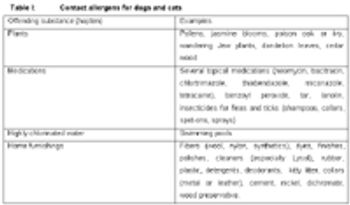Christine Rees, DVM, DACVD
Articles by Christine Rees, DVM, DACVD

Eosinophilic granuloma complex is a dermatologic condition most commonly seen in cats. Allergies such as food allergy, atopy and insect hypersensitivities have been associated with this syndrome. If the allergic cause for this dermatitis is not found than the EGC is described as being idiopathic.

Draining tracts or fistulous tracts are tract lesions that connect with a central area or focus of inflammation to the skin's surface. Draining tracts are most commonly associated with nodules which are large (greater than 0.5 cm), firm, raised usually circular lesions that extend down into the dermis.

Etiology is a type I hypersensitivity predominantly but a type III and type IV reaction may also occur. Animals are predisposed to develop food allergy through undefined genetic factors.

Several different diagnostic and medical treatment options exist for treating otitis in dogs and cats. It is important that the veterinarian know all of the options that are available so that they can make recommendations to the pet owner.

Veterinarians are always in search of the "magic bullet" to treat their dermatologic patients. This desire to obtain better treatments has lead to the discovery of many new therapies and new dermatological applications for older medications. Many of the newer treatments that we will discuss been recognized in veterinary medicine because of successes being reported anecdotally.

Canine and feline atopic dermatitis (atopy, allergic inhalant dermatitis) is a hereditary, pruritic (itchy) skin disease. The disease is caused by an allergic reaction to the inhalation of pollens, mold spores, dust, or epidermals (animal dander, feathers wool). Upon future challenge with that specific allergen, IgE molecules are bridged on the mast cell surface.

Scaling or keratinization disorders are a common dermatologic condition in dogs. This dermatologic problem can be described in two methods (i.e. clinical signs and etiology).

Signalment: 3 years old, castrated male, DSH

Shampoo therapy is an important adjuvant therapy in pets for treating a variety of dermatologic conditions. In order to get the maximum benefit of the shampoos, the shampoos need to be used properly. Contact time is of utmost importance when using shampoos.

Chili has had hair loss along the neck and ventrum for the last six months.

Pododermatitis, by definition, is the inflammation and/or infection of the skin and connective tissue of the foot.

Pruritus is the sensation to lick, itch, scratch or chew.

Canine atopic dermatitis (atopy, allergic inhalant dermatitis) is a hereditary, pruritic (itchy) skin disease.

Food allergy is a type I hypersensitivity predominantly but a type III and type IV reaction may also occur.

Staphylococcus aureus is an opportunistic pathogen that is normally found on the skin, nasopharnyx, and perineum of humans and animals.

Flea allergy dermatitis (FAD) is a hypersensitivity disorder of animals that are sensitized to allergens in flea saliva.



